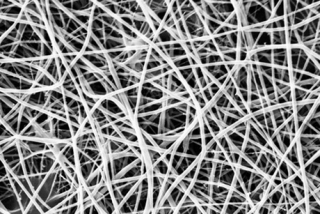Aug 14 2015
Microscopically, “nanomembrane” sheets made from nylon resemble a tangled web. The tiny iron oxide particles on the fiber surfaces can help clean toxic chemicals from water, but if the particles get separated from the web, they can become hazards themselves.
 Under a microscope, Nylon-6 fibers comprise nanomembrane sheets
Under a microscope, Nylon-6 fibers comprise nanomembrane sheets
In a new study, Cornell researchers examined these special nylon sheets – replete with applied nanoscale iron oxide particles – to see if the particles wash loose.
The particles work like magnets to capture bacteria and viruses, and to extract chemicals or dye molecules out of water. Membranes with these particles attached could be used in devices to detect water contamination or in filters to remove chemicals or dyes from industrial waste. However, to be effective and safe, the particles need to stay on the membrane. The study evaluated the nanoparticle treatment uniformity and particle retention of the nylon membranes as they were processed (or washed) in solutions of varying pH levels.
“It’s critical to evaluate particle retention and stability on fibers to reduce human health and environmental concerns,” said Nidia Trejo, a Cornell doctoral student in the field of fiber science. Trejo, who with Margaret Frey, professor of fiber science, authored the study, “A comparative study on electrosprayed, layer-by-layer, and chemically grafted nanomembranes loaded with iron oxide nanoparticles,” in the Journal of Applied Polymer Science, July 14.
The nanomembrane sheet structure looks like a dryer sheet but is made from layers of tiny, randomly oriented fibers that only can be seen with electron microscopes. These nanomembranes have a high surface-to-volume ratio, which enhances the material’s function.
Manufacturing methods vary depending on the liquid environments in which the membranes would be used. Adhering nanoparticles of iron oxide to nylon fiber is done in three ways: electrospraying, which facilitates uniform nanoparticle placement in the fibers; layer-by-layer assembly, where particles are coated on the fiber electrostatically; or chemical bonding.
“For the membrane, it’s important to evaluate particle retention and stability,” Trejo explained. “You would want the nanoparticles to stay on the Nylon 6 membranes so the material can have function throughout the life use. If the material is used for wastewater treatment applications, you wouldn’t want the particles themselves to become pollutants if are they releasing from the membranes and into the water.”
A range of state-of-the-art facilities on campus was used by the researchers. The Cornell Center for Materials Research (funded through the National Science Foundation’s Materials Research Science and Engineering Center program) supported this study through its shared facilities. Additionally, Cornell’s Nanobiotechnology Center and the Cornell Nutrient Analysis Laboratory supported this research.
Can nanofiber save your life?
Researchers in professor Margaret Frey’s lab create fibers hundreds of times thinner than a human hair that can capture toxic chemicals and pathogens. The fibers have been designed and combined to prevent the spread of agricultural chemicals and to capture toxic substances in liquids.
Tiny, complex devices traditionally are made in high-tech clean rooms using expensive equipment and costly material, like gold. Frey and her colleagues are replacing that cost by making the devices with nanofibers from plastics, outside the clean room, using an inexpensive, scalable process: electrospinning.
Using nanofibers, processes done in a medical testing lab – for example, purifying samples, mixing ingredients, capturing bacteria – can be done with material about the size of a deck of cards. The fibers are a fast, easy and inexpensive way to concentrate on E. coli, cholera toxin or carcinogens and to improve accuracy of detection. Eventually, these fibers will be part of devices as inexpensive and easy to use as home pregnancy tests and will diagnose diseases without requiring specialized laboratories – particularly useful in regions with limited access to doctors and hospitals.
To prevent pesticides from harming the environment, Frey and her students have encapsulated pesticides into biodegradable nanofibers. This keeps them intact until needed or makes sure they do not wash away from the plants they protect. The delivery system is created by electrospinning solutions of cellulose, the pesticide and polylactic acid – a polymer derived from corn.
The materials are biodegradable and derived from renewable resources. “The chemical is protected, so it won’t degrade from being exposed to air and water,” Frey said, explaining that this keeps the chemical where it needs to be and allows it to time-release. “By allowing rapid detection of disease and preventing agricultural chemical release into the environment, these nanofibers just might save a life,” she said.